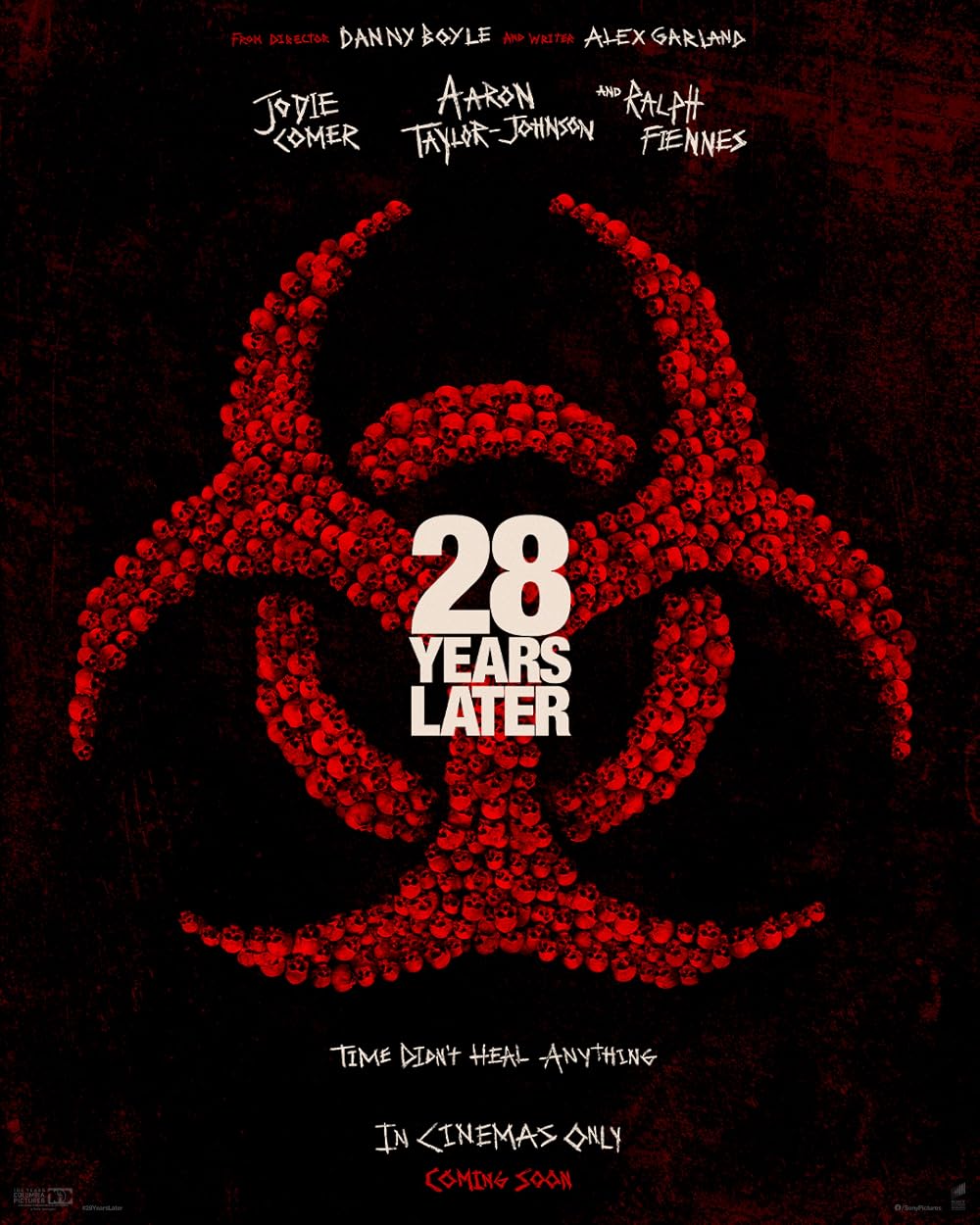The third chapter in Danny Boyle’s Rage saga finally hit theaters in June 2025, transforming a cult zombie franchise into a full-blown event. 28 Years Later reunites Boyle with original writer Alex Garland, updates the virus-ravaged U.K. for the streaming age, and delivers the series’ biggest box-office haul to date.
Here’s a deep dive into the production’s standout moments, record-breaking numbers, and what its cliff-hanger means for the 2026 sequel, 28 Years Later: The Bone Temple.
Franchise Evolution: From Camcorders to Cinematic Scope
Boyle’s 2002 original used grainy MiniDV footage to ground its horror in realism. The 2025 installment embraces that DIY spirit while scaling everything up: large-format digital cameras share screen time with iPhone shots to mimic the jittery immediacy of the first film, while sweeping drone vistas show how far the infection has spread. Garland’s script leans into modern anxieties—post-Brexit isolationism, pandemic fatigue, and a growing distrust of institutions—without sacrificing the white-knuckle chase sequences that made 28 Days Later a classic.
Casting Highlights & Breakout Performances
- Jodie Comer as Isla anchors the story with a raw, terrified resolve; her scenes with newcomer Alfie Williams (Spike) provide the emotional backbone critics keep citing.
- Chi Lewis-Parry’s Samson the Alpha is already legendary thanks to the actor’s audition—he allegedly sprinted at Boyle in full infected mode and landed the part on the spot. Samson’s hulking presence finally gives the Rage virus a recognizable “big bad.”
- Jack O’Connell’s Sir Jimmy Crystal offers the film’s most polarizing twist. Patterned after infamous real-world figures, Crystal’s cult-leader charisma reframes the Rage outbreak as a commentary on celebrity power gone toxic.
- Cillian Murphy appears in a surprise mid-credits stinger, setting long-time fans buzzing about Jim’s future role.
Box-Office Bite
Less than two weeks in, the film crossed $100 million worldwide—already eclipsing the combined global totals of the first two entries and more than recouping its reported $60 million budget. A $30 million domestic opening underscored the franchise’s new mainstream appeal, driven by premium-format screenings and streamer-era marketing that teased the mother-son storyline.
Craft & Controversy
Boyle and cinematographer Anthony Dod Mantle pepper the film with GoPro helmet footage, night-vision sequences, and stark overhead shots of empty motorways to keep the aesthetic unpredictable. Those daring choices have been applauded almost as much as the ending has been debated: the reveal of Crystal’s backstory, clearly riffing on disgraced British TV personalities, forces viewers to confront real-world monsters alongside fictional ones.
What’s Brewing in The Bone Temple
Filmed back-to-back and helmed by Nia DaCosta, the sequel drops on January 16, 2026—a neat “28 weeks” after the first film’s release. Early whispers point to:
- A deeper dive into Crystal’s cult and its chilling rituals inside an underground ossuary.
- A larger European scope, moving from London’s quarantine zones to Mediterranean catacombs.
- The return of Comer, Williams, O’Connell, Aaron Taylor-Johnson, and Murphy, with additional cast rumored from the U.K. indie scene.
- Garland’s script exploring the weaponization of collective memory—how trauma, misinformation, and hero worship mutate faster than any virus.
Quick Takeaways for Fans
- Biggest Entry Yet: Already the top-grossing film in the trilogy.
- Emotional Core: Comer and Williams ground the chaos in family stakes.
- New Villain: Samson provides physical menace; Crystal adds psychological dread.
- Bold Aesthetics: Phone footage, drones, and traditional cinema cameras blend old and new.
- Sequel Locked: The Bone Temple arrives January 2026 with principal cast and a new director.
Sony is expected to release the first teaser for The Bone Temple this fall. We’ll keep updating as trailers drop, box-office milestones roll in, and any hints surface about the trilogy’s rumored third installment. Stay tuned.
Best Horror Games in 2025
Horror games are one of gaming’s most popular genres. From classic titles that pioneered jump scares to modern psychological thrillers, these games touch on our deepest fears. Players looking for the best horror games can find options ranging from survival horror to narrative-driven experiences that will keep them on the edge of their seats.
These games do more than just scare us – they pull us into dark worlds where danger lurks around every corner. Many top horror games create a feeling of being helpless, with limited resources and powerful enemies. This special mix of fear and excitement keeps bringing gamers back for more hair-raising adventures.
1. Alien: Isolation
Alien: Isolation stands as one of the scariest horror games ever made. Since its release in 2014, few games have matched its terror-inducing gameplay.
The game puts players in a desperate fight for survival against a single, deadly xenomorph. This alien hunter stalks you through the corridors of Sevastopol Station with frightening intelligence.
What makes Alien: Isolation so effective is its perfect use of tension. You never feel safe. The alien can appear at any moment, forcing you to hide or run.
Players must use their wits rather than weapons. The xenomorph can’t be killed, only avoided. This helplessness creates genuine fear that few games achieve.
The game’s sound design deserves special praise. The hiss of steam pipes, distant footsteps, and the beeping of your motion tracker all work together to keep you on edge.
Many fans consider it the best horror game ever created. Its faithful recreation of the first Alien film’s atmosphere helps it stand out from other horror games.
The alien’s AI remains impressive even years after release. It learns from your tactics and adapts, making each encounter unpredictable and fresh.
Some players find the game so scary that they take years to finish it. This speaks to how effectively it creates an atmosphere of dread.
The game also excels in its setting. Sevastopol Station feels like a real place with its retro-futuristic design inspired by the original 1979 film.
Despite critical praise, Alien: Isolation remains somewhat underrated commercially. It didn’t sell as well as many expected, but has gained a dedicated following.
The xenomorph itself steals the show. Its movements, sounds, and hunting patterns create a believable predator that feels truly alien and dangerous.
Playing Alien: Isolation requires patience and nerve. Running through the station will get you killed quickly. Slow, careful movement is key to survival.
The game rewards brave players with one of the most intense horror experiences in gaming. Each narrow escape feels earned and thrilling.
2. Amnesia: The Bunker
Amnesia: The Bunker stands out as one of the scariest horror games in recent years. Released by Frictional Games, this title takes the fear factor to new heights in a claustrophobic World War I bunker setting.
Players control a French soldier trapped underground with a relentless monster. The game creates tension through its smart use of light and darkness. A generator powers the lights, but fuel is scarce.
The monster AI deserves special mention. Unlike scripted enemies in other games, this creature feels unpredictable. It hunts players through sound and movement, making each encounter feel fresh and terrifying.
What makes The Bunker different from other horror games is its semi-open world design. Players can tackle objectives in various ways, adding replay value to the horror experience.
The game gives players a revolver with limited bullets. This design choice strikes a perfect balance – offering some means of defense without making players too powerful. Many fans praise how this approach avoids the helplessness found in games like Outlast.
Sound design in The Bunker creates constant dread. Pipes creak, distant noises echo, and the monster’s movements keep players on edge throughout the game.
Many players report genuine fear while playing. Online discussions show numerous comments from gamers who found it genuinely scary from start to finish.
The bunker itself feels like a character with its maze-like design and dark corners. Every location holds potential danger, creating a sense that nowhere is truly safe.
Resource management adds another layer of stress. Players must carefully use fuel, bullets, and other items to survive.
Some game critics consider The Bunker a masterclass in horror game design. It combines traditional scares with innovative gameplay mechanics that keep players engaged.
For those seeking pure horror, Amnesia: The Bunker delivers an unforgettable experience. Its clever design choices and atmospheric tension make it a standout title in the horror genre.
3. The Evil Within
The Evil Within stands as a top contender in the horror game genre. Released in 2014, this game created by Resident Evil mastermind Shinji Mikami brings a unique blend of survival horror and psychological thrills.
Players follow Detective Sebastian Castellanos as he fights through a twisted world filled with grotesque monsters. The game’s strength lies in its mix of limited resources and challenging combat that keeps players on edge.
Many fans consider it one of the best survival horror games in the AAA space. The tense atmosphere and unpredictable environments make each playthrough a nerve-wracking experience.
The game uses clever level design to build tension. One notable example is the first level, where players face enemies that can kill them instantly, creating real fear and anxiety.
Some horror fans even argue that The Evil Within should be held in the same regard as classics like Resident Evil and Silent Hill. The game received an average critic score of 7.6, showing its strong reception.
The visuals feature a gritty, disturbing style that enhances the horror elements. Blood-soaked hallways and twisted creatures create a world that feels truly threatening.
Sound design plays a key role in the game’s effectiveness. The subtle audio cues warn players of nearby threats, while the soundtrack ramps up during intense moments.
The game also offers a puzzling story that keeps players guessing. The mix of reality-bending moments and psychological horror creates a unique gaming experience.
The Evil Within received a sequel in 2017 that expanded on many concepts from the original. Though both games have their fans, the original scores slightly higher with critics.
The game’s difficulty adds to its horror appeal. Limited ammo and healing items force players to make tough choices about when to fight and when to run.
For horror fans looking for a challenge, The Evil Within offers both frights and satisfying gameplay. Its unique vision of horror has helped it remain relevant even years after its release.
4. Outlast Trials
The Outlast Trials brings horror to a new level by adding cooperative gameplay to the franchise’s already terrifying formula. Released in 2024, this game lets you face nightmares with friends or brave them alone.
Unlike previous Outlast games, this entry focuses on multiplayer horror. Players take on the role of test subjects in cruel experiments run by the Murkoff Corporation during the Cold War era.
The game features several “trials” that players must complete to survive. Some of the scariest trials include “Punish the Miscreants” and “Cancel The Autopsy,” both known for their extremely dark settings that make visibility a challenge.
What makes The Outlast Trials stand out is how it creates tension between teammates. The game’s true horror often comes from having to rely on teammates for survival rather than just facing monsters alone.
The gameplay loop involves completing objectives while hiding from enemies. Players must sneak through dark corridors, solve puzzles, and work together to escape each trial alive.
Visually, the game maintains the series’ signature gritty and disturbing aesthetic. The environments are claustrophobic, dirty, and designed to create constant unease.
For some players, The Outlast Trials proves too frightening to handle. There are reports of gamers who found it so terrifying they couldn’t even finish reviewing it.
The game shines brightest during late-night sessions with friends. However, critics note that it loses charm when played solo, suggesting it was primarily designed with multiplayer in mind.
While The Outlast Trials offers intense scares and memorable moments, some reviewers mention that it burns out after a few hours of gameplay, lacking the staying power of other horror titles.
The sound design deserves special mention, with every creaking door and distant scream perfectly placed to maximize player anxiety.
For horror fans seeking a game that combines teamwork with terror, The Outlast Trials delivers a unique experience. Just be prepared to jump, scream, and possibly lose sleep after playing.
5. Resident Evil 7: Biohazard
Resident Evil 7: Biohazard marked a bold shift for the famous horror series. It moved from third-person action to first-person terror, bringing players closer to the fear. The game takes place in a creepy house in the American South, where you search for your missing wife.
The Baker family serves as the main threat in this game. They chase you through dark halls and tight spaces. Their odd behavior and near-immortal nature make every meeting with them tense and scary.
The atmosphere, soundtrack, and characters work together to create a truly frightening game. The music builds tension at just the right moments. The sound design makes players jump at every creak and groan in the old house.
The game takes a more personal approach to horror. Instead of fighting zombie hordes, you face a small cast of truly disturbing foes. The Baker family dinner scene stands out as one of gaming’s most uncomfortable moments.
Many fans and critics call it one of the best horror games ever made. The game brings the series back to its survival horror roots. You must manage limited resources while solving puzzles and avoiding enemies.
Fear and isolation are key themes throughout the game. Players often feel trapped and helpless, which adds to the scare factor. The narrow halls and dim lighting create a sense of dread that few games match.
The story unfolds through found footage tapes and notes scattered around the house. This method of storytelling keeps players engaged and hunting for more clues. Each new piece of information makes the house’s history more unsettling.
Resident Evil 7 brought new life to a series that had become too action-focused. It proved that going back to basics—fear, tension, and survival—could make Resident Evil relevant again. The switch to first-person view was risky but paid off by making the horror more direct.
Playing in VR takes the fear to another level. Being fully immersed in the Baker house makes each scare more real. Many players consider it the scariest gaming experience they’ve ever had.
6. Silent Hill 2
Silent Hill 2 stands as one of the most influential horror games ever created. Many gamers consider it the best horror game of all time, and for good reason.
The game follows James Sunderland, a man who receives a letter from his dead wife asking him to meet her in Silent Hill. This simple premise sets up one of gaming’s most twisted psychological journeys.
What makes Silent Hill 2 special is its approach to horror. Instead of relying on jump scares, it builds a constant feeling of dread and unease.
The fog-covered town creates an atmosphere unmatched in horror gaming. Players never know what lurks just beyond their view, making every step forward feel dangerous.
The monsters in Silent Hill 2 aren’t random enemies. Each creature represents something from James’s troubled mind, giving players hints about the true story.
Pyramid Head, the game’s iconic villain, has become a horror legend. His disturbing design and relentless pursuit of James create some of gaming’s most terrifying moments.
The story tackles difficult themes like guilt, grief, and punishment. It’s utterly miserable, but this bleakness is exactly what makes it so powerful.
Sound design plays a huge role in the game’s success. The static radio warns of nearby monsters, while Akira Yamaoka’s haunting soundtrack perfectly captures the town’s emptiness.
The game offers multiple endings based on player actions. These different conclusions encourage replays and deeper thinking about the story’s meaning.
In 2023, Bloober Team released a remake that stays true to the original while updating the graphics and controls. Critics have called it one of 2024’s best horror games.
Even after all these years, Silent Hill 2 remains the standard for psychological horror in games. Few titles have matched its perfect blend of disturbing imagery, emotional story, and oppressive atmosphere.
What truly sets Silent Hill 2 apart is how it connects its horror directly to human emotions. The monsters, environments, and even the fog all reflect the main character’s mental state.
For anyone interested in horror games, Silent Hill 2 is essential. Its influence can be seen in countless games that followed, proving its lasting impact on the genre.
7. Dead Space
Dead Space stands as one of the scariest horror games in gaming history. The original game puts players in the space boots of engineer Isaac Clarke as he explores the abandoned mining ship USG Ishimura.
The first game in the series delivers the most fear-inducing experience. Players must navigate tight corridors filled with terrifying creatures called Necromorphs. The game’s unique combat mechanics require shooting off enemy limbs rather than aiming for headshots.
Dead Space creates tension through its brilliant sound design. The creaking metal of the ship, distant screams, and eerie silence build dread with each step. The lack of a traditional HUD keeps players immersed, with health displayed on Isaac’s suit and ammo counts shown on weapons.
The 2023 remake enhances the horror with improved lighting and visuals while maintaining the core experience. New players can now experience this classic with modern graphics and controls.
Many gamers find the first Dead Space too frightening to finish. The game’s atmosphere creates such intense anxiety that playing in short sessions becomes necessary. This speaks to how effectively the developers crafted the horror experience.
Dead Space 2 strikes a better balance between action and horror. It introduces more varied environments and enemy types while maintaining tension. The sequel features one of gaming’s most disturbing sequences involving an eye surgery tool.
The third entry shifts toward action but still contains scary moments. Co-op play changes the experience, making it less frightening when played with friends. The weapon crafting system adds variety but dilutes some of the horror elements.
When ranking among horror greats like Resident Evil and Silent Hill, Dead Space holds its own. Its space setting, industrial design, and body horror make it unique in the genre.
The series blends sci-fi and horror perfectly. Isaac’s struggle against both the Necromorph threat and his own deteriorating mental state creates layers of terror. Few games manage this balance of psychological horror and jump scares so effectively.
8. Fatal Frame
The Fatal Frame series stands as one of the most frightening horror game franchises ever created. This Japanese horror series puts players in control of characters who must use a special camera to fight ghosts.
What makes these games so scary? Instead of running from danger, players must face ghosts head-on through their camera lens to defeat them. This creates heart-stopping moments as spirits get closer and closer.
Among the series, Fatal Frame 2: Crimson Butterfly is widely considered the scariest entry. It follows twin sisters trapped in a haunted village and features some of the most terrifying ghost designs in gaming history.
The original game introduced the concept, but the sequel perfected it. Some fans rank the games with the first and third installments following closely behind the second in terms of fear factor.
What makes Fatal Frame special is its use of Japanese horror elements. The games draw on traditional ghost stories and folklore, creating a unique horror experience different from Western games.
The sound design deserves special mention. Whispers, footsteps, and subtle noises create a constant state of unease. The games use silence effectively, making each sound more impactful.
The Fatal Frame series also excels through its psychological horror techniques. Rather than relying on jump scares, the games build dread through suggestion and anticipation.
Camera angles add to the tension. Fixed perspectives limit what players can see, increasing anxiety about what might be lurking just out of view. This design choice was ahead of its time.
While newer entries exist, many fans believe the first three games represent the series at its peak. The third game, Fatal Frame III: The Tormented, continues the high standard with its nightmare sequences and haunting story.
For horror game fans who haven’t tried Fatal Frame, it offers a unique terror experience. Few games manage to create such a persistent feeling of dread and vulnerability while still remaining playable.
9. Visage
Visage stands out as one of the most terrifying horror games in recent years. Players step into the role of Dwayne Anderson, exploring a haunted house filled with psychological and supernatural horrors.
The game creates fear through its dark, oppressive atmosphere. Players must navigate through poorly lit hallways and rooms where danger lurks in every shadow.
What makes Visage truly scary is how it forces players to face the unknown. You’ll often hear disturbing sounds before seeing their source, building tension to unbearable levels.
Many gamers consider it the scariest PC game ever made, even with some repetitive gameplay elements. The psychological themes hit hard, leaving a lasting impact.
The puzzle design deserves special praise. Each challenge feels meaningful and connected to the disturbing storyline rather than existing just to slow players down.
Visage doesn’t rely only on jump scares, though it has amazing ones. The game builds dread through its environment and sound design.
Players must manage their character’s sanity while exploring. Stay in the dark too long or witness supernatural events, and your mental state deteriorates, making you more vulnerable.
The story unfolds through environmental clues and fragmented narratives. This approach lets players piece together what happened in this house of horrors.
Each chapter explores different characters and their tragic pasts. The stories connect in unexpected ways, revealing the house’s dark influence on its residents.
The game creates what one reviewer called a pure, unfiltered nightmare. It forces you to confront fear head-on, with nowhere to hide from the horrors.
Playing Visage feels like an endurance test. The game’s suffocating atmosphere rarely gives you a moment to breathe, maintaining tension throughout.
The visual design enhances the horror with realistic environments and unsettling details. Strange photographs, creepy dolls, and disturbing imagery fill the house.
For horror fans seeking a truly frightening experience, Visage delivers. It combines psychological terror with supernatural elements in a way few games manage.
10. Condemned: Criminal Origins
Condemned: Criminal Origins is a unique entry in the horror game genre. Released in 2005, this first-person survival horror game takes a different approach by focusing on melee combat rather than gunplay.
The game puts players in the shoes of FBI agent Ethan Thomas as he hunts a serial killer. The setting consists of abandoned buildings and dark urban environments that create a constantly tense atmosphere.
Unlike many horror games, Condemned takes the “scarce ammo” concept very seriously. Having bullets feels like a rare luxury, forcing players to rely on makeshift weapons like pipes, boards, and other items found in the environment.
The combat system feels brutal and personal. Every fight is up-close, making each encounter with the game’s violent homeless people and criminals feel dangerous and intense.
What sets Condemned apart is its detective elements. Players must use forensic tools to investigate crime scenes, adding depth to the gameplay beyond simple combat and scares.
The game’s visuals still hold up well today. Dark, grimy environments create a sense of dread that few games manage to achieve. The lighting effects, particularly the way your flashlight cuts through darkness, adds to the fear factor.
Sound design in Condemned deserves special mention. The game uses audio cues masterfully to build tension. Footsteps, whispers, and disturbing noises keep players on edge throughout the experience.
Many players consider Condemned scarier than its contemporary F.E.A.R., which says a lot about its horror credentials. The game doesn’t rely on jump scares but instead builds a constant feeling of dread.
The story takes some surprising turns as it explores both crime and supernatural elements. While not perfect, it provides enough mystery to keep players moving forward through the frightening environments.
Condemned combines FPS elements with survival horror brilliantly. The focus on melee combat and investigation creates a horror experience that feels different from other games in the genre.
For those seeking a fantastic horror experience that emphasizes atmosphere and tension over gore, Condemned: Criminal Origins remains worth playing even years after its release.
Understanding Horror Game Genres
Horror games come in different types, each with its own way of scaring players. These games use unique methods and gameplay styles to create fear and tension.
Survival Horror
Survival Horror games focus on limited resources and the struggle to stay alive. Players must manage inventory items like ammo, health, and tools while facing threats. This creates tension through scarcity.
These games often include:
- Limited ammunition and healing items
- Inventory management
- Vulnerable protagonists
Survival Horror offers excellent replay value because player choices affect outcomes. Games like Resident Evil and Silent Hill defined this genre, putting players in situations where running is sometimes better than fighting.
The restricted view (often first-person or fixed camera angles) adds to the fear. Players can’t always see what’s coming, making even empty hallways feel threatening.
Psychological Horror
Psychological Horror games target the mind rather than relying on jump scares. They build dread through story, setting, and atmosphere.
These games typically feature:
- Unreliable narrators
- Mind-bending reality shifts
- Personal trauma explored through gameplay
The fear comes from questioning what’s real. Games like Silent Hill 2 and Layers of Fear use the player’s imagination as a weapon.
Unlike action-heavy horror games, psychological horror often uses subtle audio cues, distorted visuals, and narrative tricks. The monsters might represent inner demons or past mistakes.
This genre makes players uncomfortable by breaking gaming conventions and expectations. The true horror lies in the uncertainty and the slow reveal of disturbing truths.
Design Elements in Horror Games
Horror games use specific design techniques to create fear and tension. These elements work together to build a scary experience that keeps players on edge.
Atmospheric Sound Design
Sound is one of the most important elements in horror games. Good sound design can make the difference between a mediocre game and a terrifying one.
Key elements of effective horror sound design include:
- Ambient noises: Distant creaks, whispers, and unexplained sounds
- Strategic silence: Creating tension through quiet moments
- Audio cues: Warning players of danger
- 3D positional audio: Helping players locate threats by sound
Music in horror games often uses dissonant tones and unusual instruments. These sounds create unease even when nothing scary is happening on screen.
Sound effects like footsteps, breathing, and heartbeats can increase tension. They remind players of their vulnerability. Many horror games elevate heart rates through sound alone.
Narrative Techniques
Horror games tell stories in ways that build dread and mystery. Good pacing is crucial – knowing when to scare players and when to let them relax.
Effective horror narrative techniques include:
Limited information: Giving players just enough story to be intrigued but not enough to feel safe
Environmental storytelling: Telling stories through the game world rather than dialogue
Player isolation: Making the player feel alone and vulnerable
Horror games often use notes, audio logs, and visual clues to build their stories. This creates atmosphere while letting players piece together what happened.
The best horror games make players active participants in uncovering the story. This involvement makes the scares more personal and effective.
Frequently Asked Questions
Horror game fans often ask about specific experiences, platforms, and game types. Let’s look at the most common questions to help you find your next scary adventure.
Which horror games offer the most immersive experiences on PC?
PC horror games with top immersion include Alien: Isolation, known for its advanced AI that creates unpredictable encounters. The game’s atmosphere and sound design make players feel truly hunted.
Resident Evil 7: Biohazard delivers incredible immersion through its first-person perspective and detailed environments. The Baker family mansion feels terrifyingly real with its decaying rooms and hidden passages.
Amnesia: The Bunker creates tension through its dynamic sound system and resource management. Players must carefully plan each move while a relentless monster hunts them.
What are some highly recommended horror games for Android devices?
Mobile horror fans can enjoy several quality titles on Android. Five Nights at Freddy’s remains popular with its simple but effective jump-scare mechanics and tense resource management.
Eyes: The Horror Game delivers short but intense experiences perfect for mobile play. Its ghost-avoiding gameplay works well with touch controls.
Distraint offers psychological horror in a side-scrolling format that runs smoothly on most devices. Its distinctive art style and disturbing story make it stand out.
Which horror games have multiplayer features and are well-received by the community?
Outlast Trials provides cooperative horror where players work together to escape experimental facilities. The shared fear experience creates memorable gaming moments.
Dead by Daylight remains a favorite with its asymmetric gameplay. One player becomes the killer while others try to escape, creating unique dynamics each match.
Phasmophobia gained massive popularity for its ghost-hunting gameplay that requires real teamwork. Using voice recognition and various tools to identify spirits keeps the experience fresh.
What are the top-rated horror games currently available on the Xbox platform?
Xbox players have access to several outstanding horror games. The Evil Within offers a disturbing journey through twisted realities with impressive visuals and challenging gameplay.
Dead Space Remake brings the classic space horror to modern hardware with enhanced graphics and refined controls. The strategic dismemberment mechanics still feel satisfying.
Layers of Fear 2 provides an artistic, psychological horror experience that uses the visual capabilities of Xbox hardware to create disturbing environments.
Can you suggest some horror games that are free and well-regarded by players?
Several quality horror games cost nothing to try. Doki Doki Literature Club appears innocent but transforms into psychological horror that has earned cult status among fans.
SCP: Containment Breach offers tense gameplay based on the popular collaborative fiction project. Its randomly generated elements create new scares in each playthrough.
The free chapters of creepy ritual games like Spookys Jump Scare Mansion provide solid horror experiences without cost. The full game can be purchased later if you enjoy it.
What titles are considered to be the best psychological horror games?
Silent Hill 2 remains the benchmark for psychological horror. The game has deep themes of guilt and personal demons. The foggy town still creates unease even years after release.
SOMA challenges players with questions about consciousness and humanity. Its underwater facility setting adds claustrophobia to the existential dread.
Visage takes inspiration from P.T. and expands on its concepts. The ever-changing house filled with personal traumas creates genuine psychological discomfort that lingers after playing.







